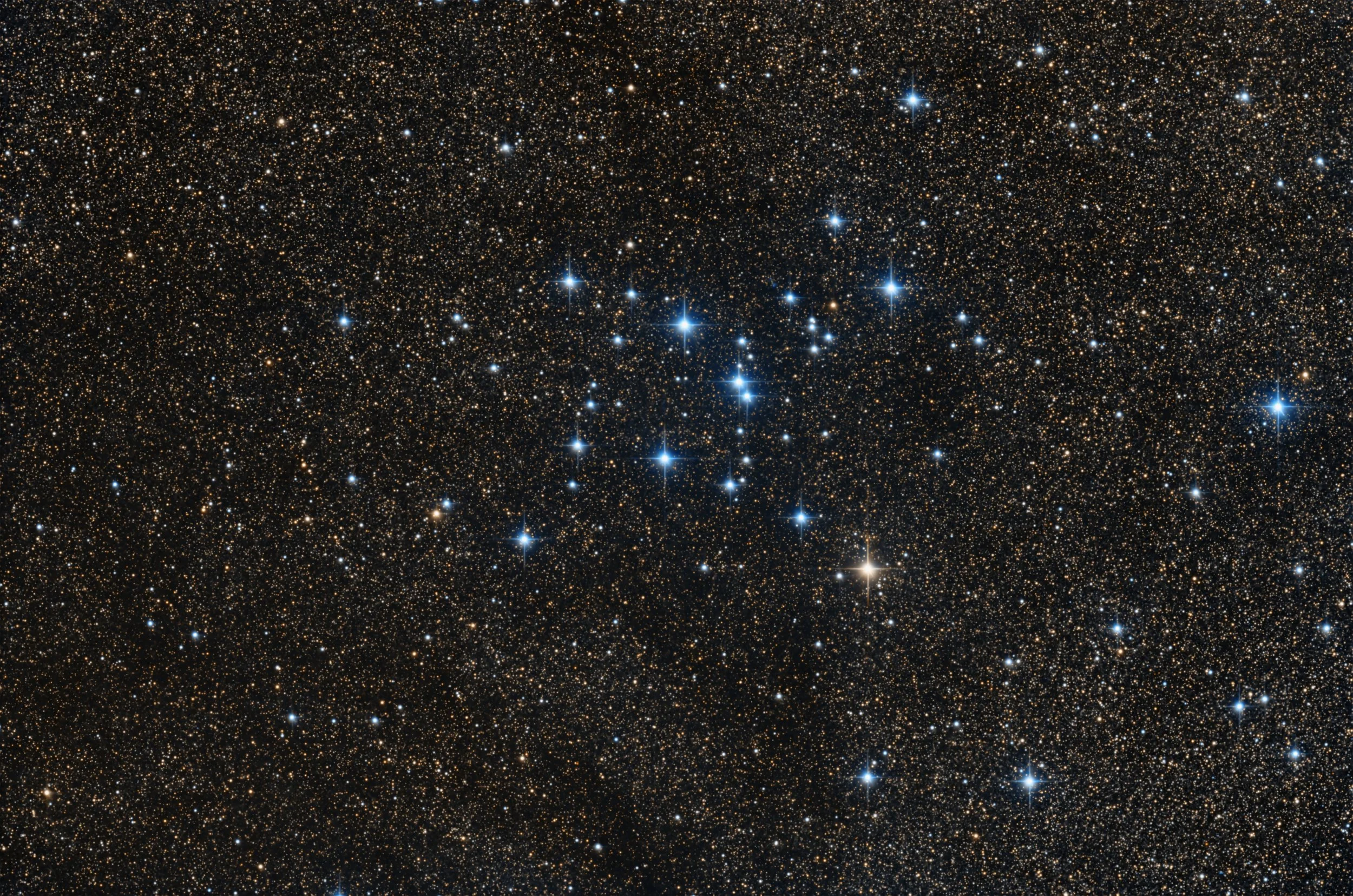M7
NGC 6475, Ptolemy’s Cluster, Scorpion’s Tail
47’ x 31’ | 0.3”/px | 9415 × 6236 px | full resolution
Scorpius
RA 17h 53m Dec -34° 49’ | 0°



Messier 7 (NGC 6475), sometimes known as Ptolemy's Cluster, is an open cluster of stars in the constellation of Scorpius. The cluster is easily detectable with the naked eye, close to the "stinger" of Scorpius. With a declination of −34.8°, it is the southernmost Messier object. M7 has been known since antiquity; it was first recorded by the 2nd-century Greek-Roman astronomer Ptolemy, who described it as a nebula in 130 AD. Italian astronomer Giovanni Batista Hodierna observed it before 1654 and counted 30 stars in it. In 1764, French astronomer Charles Messier catalogued the cluster as the seventh member in his list of comet-like objects. English astronomer John Herschel described it as "coarsely scattered clusters of stars". In Chinese astronomy it is identified as Yú, the Fish. Telescopic observations of the cluster reveal about 80 stars within a field of view of 1.3° across. At the cluster's estimated distance of 980 light years this corresponds to an actual diameter of 25 light years. The tidal radius of the cluster is 40.1 lightyear and it has a combined mass of about 735 times the mass of the Sun. The age of the cluster is around 200 million years while the brightest member star is of magnitude 5.6. In terms of composition, the cluster contains a similar abundance of elements other than hydrogen and helium as the Sun.
source: Wikipedia
Data Acquisition
Data was collected over 3 nights in June 2025, mostly under full moon conditions, using a 14” reflector telescope with full-frame camera at the remote observatory in Spain. Data was gathered using standard RGB filters. M7 is the most southern Messier object and from the observatory in Spain it reaches a maximum altitude of 18° in the South. Images were taken between 2 hours before and 2 hours after transit to capture under the best conditions. Still these were sub-optimal conditions and 12 red frames had to be rejected because of bad quality. A total of approximately 7 hours of data was finally combined to create the final image.
Location Remote hosting facility IC Astronomy in Oria, Spain (37°N 2°W)
Sessions
Frames
Equipment
Telescope
Mount
Camera
Filters
Guiding
Accessoires
Software
Planewave CDK14 (2563mm @ f/7.2), Optec Gemini Rotating focuser
10Micron GM2000HPS, custom pier
Moravian C3-61000 Pro (full frame), cooled to -10 ºC
Chroma 2” RGB unmounted, Moravian filterwheel L, 7-position
Unguided
Compulab Tensor I-22, Dragonfly, Pegasus Ultimate Powerbox v2
Voyager Advanced, Viking, Mountwizzard4, Astroplanner, PixInsight 1.9.3
Processing
All processing was done in Pixsinsight unless stated otherwise. Default features were enhanced using scripts and tools from RC-Astro, SetiAstro, GraXpert, CosmicPhotons and others. Images were calibrated using 50 Darks, 50 Flats, and 50 Flat-Darks, registered and integrated using WeightedBatchPreProcessing (WBPP). The processing workflow diagram below outlines the steps taken to create the final image.
No luminance data was collected. M7 is a straightforward object with no particular faint structures and the images were taken under (near) full moon conditions. This means that luminance does not add too much to the final details of the image, so the focus was to just record RGB.
For stretching a couple of different approaches were tested, but the combination of an algorithmic stretch using the SmartStretch scriptlet in PixelMathUI and manual tweaking using HistogramTransformation and CurvesTransformation appeared to give the most pleasing results. Later in the processing some additional steps were included to intensify the colours of the blue stars and remove any slight magenta and green colour casts.
The full processing workflow is shown below.
Processing workflow (click to enlarge)
This image has been published on Astrobin.
